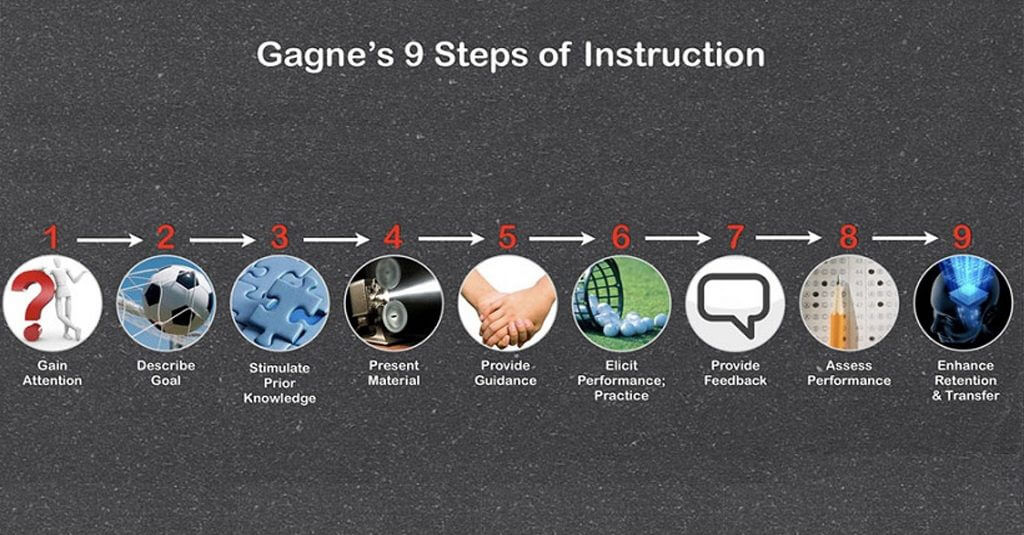To follow the behaviorist approach of e-learning, most industry experts have adopted Gagné’s 9 Events of Instruction. It helps learners relate e-course content with something they already know or have experienced.
Over the last few years, e-learning has become the most preferred means of learning for both the corporate and the education domain. E-learning is a cost-effective way to deliver online learning courses to learners worldwide. The self-paced nature of the e-learning experience results in high retention of employees at the workplace. Learners can access training content online, without wasting their time and budget. A plethora of methods can be followed in e-learning, and developers need to choose the one that best fits their requirements as well as aligns well with a technology-aided platform. Given below is the list of Gagné’s 9 Events of Instruction:
- Gaining the learner’s attention
- Informing the learner of the objectives
- Stimulating recall of prior learning
- Presenting the learning stimulus
- Providing learning guidance
- Eliciting appropriate performance
- Providing feedback
- Assessing learner performance
- Enhancing retention and transfer
There are several ways of applying Gagné’s Nine Events of Instruction to deliver effective e-learning courses, as follows:
1. Grab the learner’s attention
There are multiple ways of seeking the attention of the learner. These are:
- Ask questions so that learners get ready to think and respond quickly.
- Integrate storytelling so that learners can relate with the scenario.
- Show an interactive video as a brief introduction.
- Stimulate learners with uncertain situations and surprises.
2. Explain the objectives
It is important to inform students about the objectives or outcomes that help them understand the e-learning course contains. Well-prepared learning goals lay the groundwork for assessing the performance of learners. A few methods to state the e-learning course outcomes include:
- Describing the performance of the students
- Describing the required performance parameters
3. Stimulate recall of prior learning
This enables learners to build on their previous expertise or skills because it is comparatively easier to build on something you know already. It can be done by:
- Asking open-ended questions from students about their previous experiences
- Taking quizzes based on prior knowledge
- Asking learners about their understanding on previous concepts
4. Present the e-course content
There are many ways to make your online learning course more engaging for learners:
- Storytelling: Narrate the training content like a story to which the learners can relate.
- Content chunking: Deliver content in the form of chunks, so that it is easy to understand.
- Gamification: Turn the training course into the form of a game by integrating points, badges, and other gaming elements.
- Offering multiple delivery platforms: Deliver multiple versions of learning content, such as demos, podcasts, and lectures.
5. Provide learning guidance
In addition to sharing learning content, it is essential to share instructions on how to learn. Various methods to provide guidance include:
- Offer instructional support in the form of scaffolds, which can be removed after students learn the content.
- Provide analogies and case studies based on real-world applications.
6. Elicit performance
The trainer elicits the learners to practice what has been taught during the training program.
- Involve the maximum number of learners by including interactive content, such as audios and videos.
- The 2D and 3D diagrams can be made more interactive with graphic animations and texts.
7. Give feedback
Include various types of feedback for student performance:
- Corrective feedback: To inform the learner about the accuracy of their overall performance.
- Informative feedback: To give suggestions to the learner to correct performance.
8. Assess performance
You can assess performance by embedding tests and quizzes. If the learning objectives are clear, it is easier to create assessments.
- When learners wish to take up the test, they can register with their name, course ID, and password. Test items are displayed on the screen and the learner can take up the test on any mobile device by punching in the answers.
- This is an effective way of tapping the ability of learners.
- With each test, the level is also increased.
9. Better retention
After the learners master new skills, the chances of their retention increase.
- Interactive videos, audio clips, and checklists are included in e-learning courses to sustain training.
- The mobile platform is suitable to meet tailored learning needs as learners can access information anytime and anywhere.
Today, the face of e-learning training has changed. It has become very important to incorporate efficient e-learning methods to benefit your organization’s biggest asset: the workforce.
Source and suggested further reading: Applying Gagné’s 9 Events Of Instruction In eLearning








